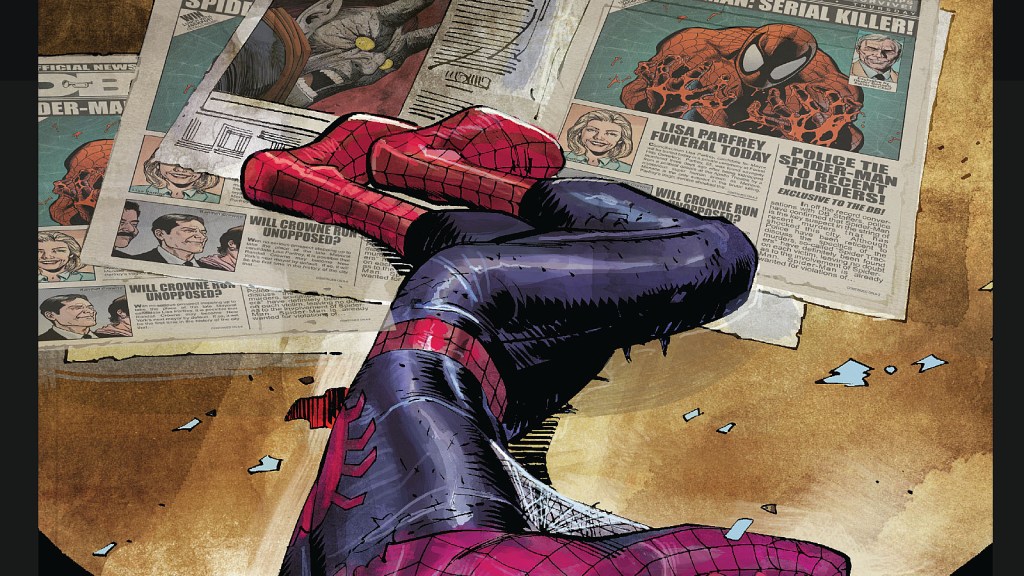
In the American superhero comic book tradition, there’s no such thing as a bad series—only bad story arcs. Few examples prove this better than The Amazing Spider-Man‘s “Brand New Day” storyline. Coming right after one of the most controversial episodes in Spider-Man history — the widely criticized “One More Day” arc — “Brand New Day” went a long way toward restoring fans’ faith in the Spider-Man franchise and Marvel’s ability to tell a compelling Spidey tale. While many readers found comfort in its return to the “old-school” Spider-Man style, there was more to it than just nostalgia. The storyline also featured several strong sub-plots that stood on their own as solid Webhead material, even without relying on any goodwill they might have earned by following such a divisive arc.
One of the best of these sub-plots is Marc Guggenheim and John Romita Jr.’s “Spider-Tracer Killer,” which ran in The Amazing Spider-Man #584-588. What sets this mini-arc apart from the others that make up “Brand New Day” isn’t about getting “back to basics” or explaining away creative mistakes. Rather, it presents a short but complete whodunit-style side story that poses a rarely asked question: What do the police really think about Spider-Man? It’s a compelling angle that fans often overlook. With all the help Spidey gives law enforcement, it’s easy to assume the police naturally support him, but this arc challenges that assumption in a thoughtful and suspenseful way.
Brand New Day’s Best Kept Secret

As a result of the fallout from “One More Day,” Spider-Man’s life has changed dramatically. Fans will recall that the story ended with Peter Parker, Mary Jane Watson, and Mephisto striking a deal: in exchange for Aunt May’s life, their entire history as a married couple — along with public knowledge of Peter’s identity as Spider-Man — was erased. “Brand New Day” thus begins with a soft reboot of the Spider-Man continuity: Aunt May is alive, Peter is single, Mary Jane’s whereabouts are unknown, and his secret identity has been restored. Most importantly, Spider-Man returns to fighting crime as a masked vigilante.
While police generally appreciated any help in fighting crime from Spider-Man, his refusal to identify himself, his disobedience of city and federal anti-vigilante laws, and his tendency to cause destruction and chaos made him a significant policing problem. Moreover, J. Jonah Jameson’s relentless use of his high profile to vilify Spider-Man and criticize the police as incompetent further fueled negative attitudes toward the web-slinger among law enforcement.
It’s in this charged atmosphere that “Spider Tracer Killer” unfolds — and it starts with a bang. New York City, in the middle of a heated mayoral race, is gripped by a bizarre crime spree: low-level criminals are turning up dead, and each body is found with one chilling clue — Spider-Man’s signature tracer bug. It doesn’t take long for J. Jonah Jameson to run wild with the story, loudly proclaiming to anyone who’ll listen that Spider-Man must be behind the killings. Before long, the police officially name Spider-Man as a person of interest, and the hunt to bring him to justice is on.
The Underappreciated Genius of “Spider-Tracer Killer”

On the surface, “Spider Tracer Killer” might seem like an ordinary Spider-Man subplot within a larger story arc. But as the narrative unfolds, it becomes clear that it contains all the hallmarks of a classic mystery. There’s the central mystery — not only leaving readers guessing who the killer might be, but also raising the bigger question: who would go to such lengths to frame Spider-Man? Then there’s the colorful cast of suspects.
While readers can guess Peter isn’t the culprit, suspicion falls on a number of figures around him. his old friend Harry Osborn, his roommate Vin Gonzalez, his girlfriend Carlie Cooper, or even the supervillain Menace. The story also features a trail of clues and red herrings that lead readers down one path, only to subvert expectations in the end. And, of course, there’s the surprise reveal of the real killer. All these elements combine to form a gripping narrative that keeps readers hooked from beginning to end.
But it’s more than just a mystery; it’s also a compelling exposé on Peter Parker and what makes Spider-Man so special. While he’s never been the most popular super-powered citizen, he’s never been hunted as “Public Enemy #1” either. This puts him in quite a bind as he tries to stop Menace while police actively target him. In one close call, he’s shot in the shoulder, and with little time for medical attention or to heal, he must fight on, effectively with just one arm. This scenario offers a great exploration of what makes Spider-Man such a beloved character.
Beyond the Backlash: Unpacking the “Spider-Tracer Killer”

In a special twist, “Spider Tracer Killer” explores one of the most fundamental yet complex dynamics in superhero comics: the relationship between the hero and the police. The story subverts the common assumption that their collaboration is always seamless. As the story makes clear, though their end goals may align, their differing methods frequently create friction, and in the case of Spider-Man, even outright conflict.
Despite the widespread unpopularity of “One More Day,” the Spider-Man fan base responded positively to “Brand New Day” and its return to a more traditional portrayal of Spider-Man, along with a storytelling style that refocused on “superheroism.” Within this broader narrative, several standout sub-plots reminded fans why Spider-Man remains such a compelling title, even when certain story arcs fall flat. One such sub-plot, “Spider-Tracer Killer,” blends solid storytelling with captivating artwork to deliver a brief but engaging Spidey tale.
The post There Is One Element of Spider-Man: Brand New Day That is Actually Good appeared first on ComicBook.com.


